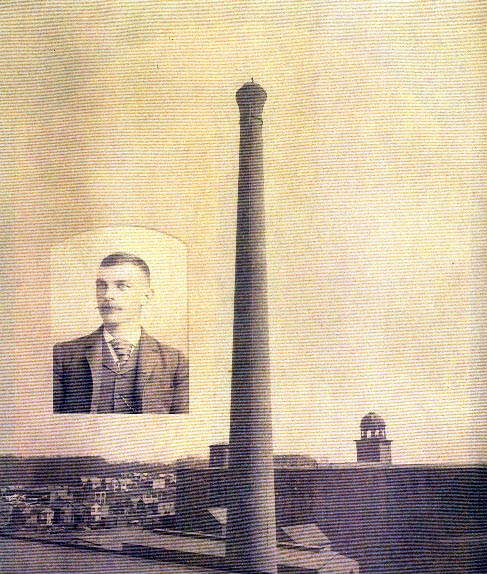|
UP THE BIG CHIMNEY The
NEWARK EVENING NEWS
Climbing the pile with ladders Daring Work of John Phillips, Who is Working His Way to the Top of the Lofty Structure—How He is Doing It—Crowds Watch the Work.
Since last Friday, when the batteries of Heaven’s artillery trained their lightning bolts on the majestic pile of 1,750,000 bricks that tower hundreds of feet above the O.N.T. thread mills at Kearny, the Clarks, and scores of others, have been wrestling with the problem of the battered stack’s repair. Men who had successfully combated tariff problems, and the intricacies of thread spinning, combinations and trusts, and other men skilled in mastering the difficulties attendant with the running of flag ropes to the tops of liberty poles, and the buildings of roofs and steeples, combined their ingenuity to form plans for scaling the smooth and perpendicular surface of the great chimney. Some suggested that a balloon be utilized to carry a man to the mouth of the stack 335 feet above the ground. From his position in the balloon, it was argued that the bold passenger could construct rigging, from which ropes could be suspended, and attach a swinging scaffolding prepared for workmen. Some thought that a kite could be sent up, and that by deft management, a rope sufficiently strong for the purpose could be strung across the mouth of the stack and utilized in the rigging of scaffolding. Others held to the idea that a clever archer, with a substantial bow and arrow, might shoot a string over the chimney.
Help from Volunteers Volunteers came around with suggestions. One little old man went so far as to declare that a "lively lad" could fasten a rope about his waist, step inside the stack at the base, and be swept upward by the powerful draught. All these suggestions were considered as wild and impracticable. John Phillips, of the firm of W. Smith & Co., slate roofers, was asked if he thought he could reach the top of this, the tallest chimney in the United States, and the second tallest chimney in the world. He sized up the situation, and in a matter-of-fact way, remarked that he knew of no better or easier way than to go up on a ladder. "A ladder! That’s good," laughed a member of the Clark family. "Of course, you know that we are in earnest." "Not more so than I am," replied Phillips. "I’ll go up there with ladders if you make it an object for me." The upshot of the conversation was that the thread manufacturers agreed to make it an object.
Daring work on the stack. This morning, Phillips, was calmly at work 125 feet above the terra firma, building a footpath of ladders to the top of the mammoth stack. The daring and nervy "Steeple Jack," as Phillips is called, could be seen from this city, like a white speck on the red pile, high above the surrounding buildings, pegging away with the energy of a hungry woodpecker in quest of food. Along the banks of the Erie Railroad, on the roofs of houses, and in fact, at every point of vantage in the vicinity of the chimney, were gathered scores of curious people gazing at the workman on his perilous midair perch. The task of constructing a line of ladders to the chimney top is all Phillips is required to do. He began his work yesterday morning. A pile of new ladders was placed at his disposal, and several men are assisting him in his labors. Phillips placed a thirty-foot ladder against the chimney, on the side opposite to that struck by lightning. The bottom of the ladder was firmly imbedded in the ground. The top was fastened by a number of strong iron spikes, driven into the stock between the layers of brick. The ends of the spikes that are forced into the chimney are flat, so as to yield, a firmer hold. The spikes are about eighteen inches in length, and the ends that clasp the ladder are so crooked as to prevent them from shifting from the original position.
How the work is done. At noon today, nine ladders were ranged up the
chimney. After placing one above the other, and securely splicing them
by means of stout rope and the iron spikes, the plucky climber moves
upward, and with hammer and spikes fixes a place for a new ladder. In
arranging the ladders, Phillips laps the new one to the last of those
already secured for a distance of about five feet, and carefully binds
the two with rope. The spikes then follow. At the spots where the
ladders join, there are placed strips, about eight or ten inches wide
and about two inches thick. They rest on the spikes and are fastened to
the ladder. By this device, a space is left between the chimney and the
ladder, which enables the climber to secure a safe foothold. The blocks
also serve as resting-places for materials used in splicing ladders. A
pulley is attached to the highest block, and assistants work the ropes
from the ground. These ropes pass up ladders, rope, spikes and other
materials.
"Steeple
Jack" John Phillips and the O.N.T. Chimney.
|
